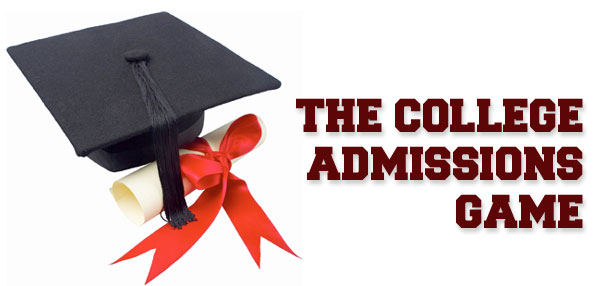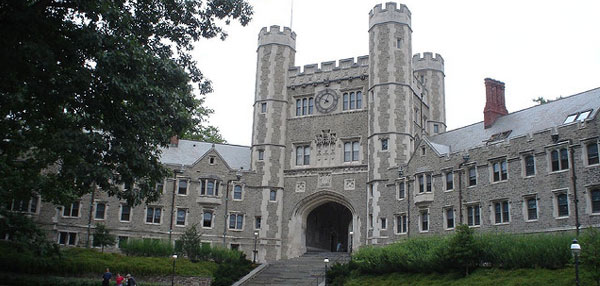
As we prepared to leave The Daughter to start her freshman year of college, she started crying. The Wife started crying also. I was mostly numb as I wondered, how did we get to this point? Is this the culmination of a year of applications, tests, and waiting? At the same time that The Daughter was applying to college, Number One Son was applying to private high schools. In Silicon Valley, applying to private high schools is a game almost as competitive and stressful as applying to college and is seen as a key stepping stone to college. I call it a game because that what it is – a game that parents and students play in order to get what they perceive as the big prize – admission to the college or high school of choice. Step one in the game is picking schools. In this series about our journey through the admissions process, this is part one: how students and parents pick schools.
During the summer before her senior year, The Daughter and I went to college fairs, full of private and public colleges from all over the country and even some from outside of the U.S. The Daughter’s high school provides a tool called Naviance that allows students to enter their GPA and test scores and see the colleges for which they have a competitive chance. I thought about the advantage it gives private schools and well off public schools that could pay for it, and about how students from poorer schools are at a disadvantage. For Number One Son, late summer and early fall is high school information night season, where Silicon Valley private Catholic schools hold information sessions. From these fairs, sessions, and online tools, we gathered information to make a number of critical school choices. Ivy or non Ivy. Public or Private. Close or far.
“I want my children to go to Ivy league schools” – a Asian American coworker, who was picking the elementary schools that would feed into the right high schools that would feed to Ivy League schools.
Every Asian parent wants their kid to go to an Ivy, right? As an Ivy League alum, I would have been proud if The Daughter went to an Ivy, and I knew that she would have an admissions advantage being the child of an alum. As an Ivy admissions interviewer (a function given to alums), I also saw what kind of students applied and how so few got in, no matter how fantastic they were. The Daughter was a good student and active too, but not the “walk on water” type of students that gets in. I decided we would not push the big name schools and concentrate on what would be a good fit with her interests and get her out in four years. For Number One Son, high school equivalents of the Ivy League exist. There are a number of schools with tuition in the $30K range with elite programs in math and science, producing many finalists in science and engineering fairs.

The goal of getting The Daughter out of college in four years pretty much drove the public or private college choice. As California public college funding has deteriorated, graduating in four years is very unlikely as majors become impacted and classes become unavailable. Not impossible, but 5 to 6 years is much more likely. With Number One Son following her four years later, The Wife and I didn’t want to worry about two in college at the same time. That additional years help drive decisions about costs. Four years of University of California vs four years of private college – public college is definitely much cheaper. Six years of University of California plus two years of lost income (the opportunity cost of those two extra years of school) vs four years of private college – the difference is much less.
Number One Son’s choice of high school was either private schools or a not so good local public school. While I have interviewed students from that high school who did get into my Ivy, the school has its share of gang members. We could try to lie about where we live to get into a better public high school (common tactic in our area), but we did not want to perpetrate fraud. We also thought about the strategy of getting him to do really well at a not so good school. This strategy, done by some Asian American parents, would position him better given UC admissions standards (top %3 of schools get in) and to private schools.
In the end, The Daughter applied to twelve private schools scattered from New England, the Pacific Northwest to Southern California. She applied to no local colleges, because she said as many teenagers do, “I want to get out of here!” She picked two public colleges for backup. Number One Son had an all private school strategy, with what we perceived as the easiest to get into school as his backup strategy. He applied to three private Catholic Schools, which are much cheaper than the elite high schools. He also had an admission advantage coming from a Catholic school. The Wife and I preferred that he go to a school that has a great education, even if he wouldn’t be one of the top students, as we wanted him to concentrate on learning as much as he could something rather than looking good in comparison to others.
Next part: Part 2: Race and School Selection.
- Part 1: Picking Schools
- Part 2: Race and School Selection
- Part 3: An Admissions Officer Speaks!
- Part 4: The School Visit
- Part 5: The Admissions Consultant
- Part 6: Admissions Test Preparation
- Part 7: Applications
- Part 8: The Interview
- Part 9: Aftermath
[flickr photo credit: Yakinodi]







